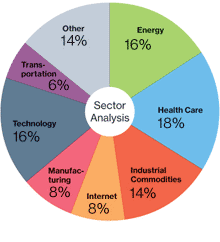| Published: Date: Updated: Author: |
The Bahamas Investor Magazine January 19, 2012 January 19, 2012 Steve Cotterill |
The health-care sector is vast, incorporating everything from pharmaceuticals to biotechnology to medical devices, hospitals, clinics and health insurance. From an investment point of view, this can be both the sector’s strength and its weakness.
 The Bloomberg Businessweek 50 ranking of the top-performing stocks in the Standard & Poor’s 500-stock index over a recent five-year period highlights a number of high achievers within the health-care sector. The companies on the list have returned an aggregate 222.3 per cent to shareholders, including reinvested dividends. Those investors that had bought stock in these companies and held on to it for the five-year period would have seen their investment returned three-fold. The ranking covers the period from March 31, 2005, to March 31, 2010. At 18 per cent, the health-care sector as a whole accounts for the single largest proportion of any category within the Bloomberg ranking analysis (see graph).
The Bloomberg Businessweek 50 ranking of the top-performing stocks in the Standard & Poor’s 500-stock index over a recent five-year period highlights a number of high achievers within the health-care sector. The companies on the list have returned an aggregate 222.3 per cent to shareholders, including reinvested dividends. Those investors that had bought stock in these companies and held on to it for the five-year period would have seen their investment returned three-fold. The ranking covers the period from March 31, 2005, to March 31, 2010. At 18 per cent, the health-care sector as a whole accounts for the single largest proportion of any category within the Bloomberg ranking analysis (see graph).
It is clear then that there are profitable investment opportunities both in the overall sector and in the individual industries that reside within that category. However, investments in this sector are influenced by many variables, including demographic, political and social factors, and it is important to understand the underlying dynamics of each individual industry when choosing a company in which to invest.
Global trends spur growth
There are certain trends that are underpinning growth in the sector as a whole. These include:
- The demographics of an aging population–in many parts of the developed world birth rates have slowed and the baby boomer generation is now approaching old age, requiring more care.
- Longevity–people are living longer, giving rise to an increased occurrence of chronic illnesses.
- In recent years there has been a significant rise in lifestyle-related health problems in developed economies, such as obesity and diabetes.
- Technological advancements have broadened and enhanced the range of products and services in the medical field.
- The globalization of populations has meant that the spread of disease is rarely hindered by international borders.
- Global population growth–the world’s population reached 7 billion towards the end of 2011, according to the United Nations Population Division, with an average growth increment of two individuals every second.
These prevalent trends are likely to continue for the foreseeable future, with demand for health-care products being bolstered by developing economies, as populations become more wealthy, access to medical products and services improves and people start to live longer.
Diverse drivers
With such underlying fundamentals, the sector seems to offer sound investment opportunities, but individual industries have their own peculiar idiosyncrasies, which have implications for the investor.
The most profitable and most complex industry within the sector is drug manufacturing, including both pharmaceutical and biotech companies. Although they are by far the best performers in the sector, they carry their own set of risks, as they are subject to a number of diverse drivers.
These companies, by their very nature, are compelled to invest heavily in research and development. Growth in the industry is spurred by the creation of medicines to treat new or existing conditions. The success rate in discovering new compounds that are effective is extremely low, and the process is costly and time consuming.
Even if a company appears to have found a viable product, other factors have to be considered and understood by the investor, such as:
• The process of getting the product to market, specifically the clinical trials required by the Food and Drug Administration (FDA). These can be exceptionally rigorous and can hold up access to the market for many months, if not years.
• The nature of the illness or disease that the product has been designed to treat. An investor needs to know how many people are affected by the disease, so determining market size. Are there other drugs on the market that treat a similar condition? Are there generic versions of the compounds already available on the market?
• Patents are central to the intrinsic worth of a company. Without property rights, the product cannot be marketed. Many companies, even dependable blue-chips, may appear to have been overlooked by investors and consequently undervalued, but that may be due to pending or expiring patents.
• The industry is highly susceptible to clinical-trial data and FDA public advisory policy. Surprises from either quarter can be both positive and negative, and both will exert immediate and substantial influence on stock prices.
Portfolio diversification
Other industries within the sector such as health insurance, hospitals and clinics have their own set of dynamics and can be strongly impacted by national health-care programmes and government policy.
To safeguard against industry-specific risk, and, even more critically, company-specific risk, investment vehicles such as exchange traded funds (ETFs) and health-care mutual funds have become more prominent, as they reduce volatility and diversify holdings. Health-care stocks, most notably biotech and pharmaceuticals, can do well in a market rally, especially when other sectors, such as finance and industrials, have been leading the recovery, meaning that health-care stock valuations are compressed. In this environment, generous returns on investment are possible, but even then, health care presents the best opportunities as part of a diversified portfolio due to the complex factors influencing growth in the sector and the level of investor engagement it demands.









